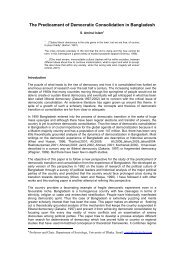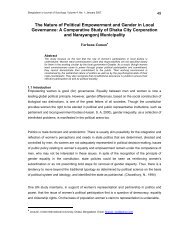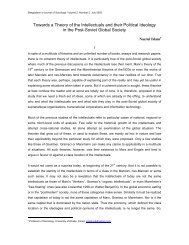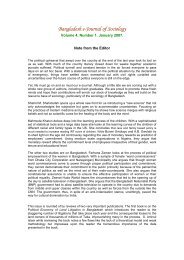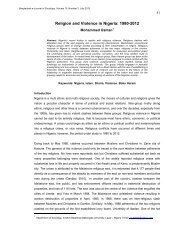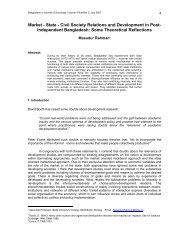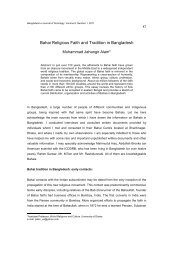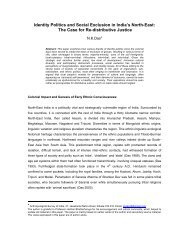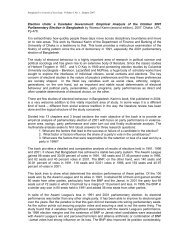An Assessment of the Role of School Counsellors in Preventing HIV ...
An Assessment of the Role of School Counsellors in Preventing HIV ...
An Assessment of the Role of School Counsellors in Preventing HIV ...
Create successful ePaper yourself
Turn your PDF publications into a flip-book with our unique Google optimized e-Paper software.
<strong>An</strong> <strong>Assessment</strong> <strong>of</strong> <strong>the</strong> <strong>Role</strong> <strong>of</strong> <strong>School</strong> <strong>Counsellors</strong> <strong>in</strong>Prevent<strong>in</strong>g <strong>HIV</strong>/AIDS among Secondary <strong>School</strong> Students <strong>in</strong>Osun State, NigeriaMary Aduke Ajila *, Chris O. Ajila ** , D.O. Adeyemo *** , and A.A. Owojori ****AbstractThe study <strong>in</strong>vestigated <strong>the</strong> level <strong>of</strong> awareness <strong>of</strong> <strong>HIV</strong>/AIDS among secondary school students <strong>in</strong>Osun State, It assessed <strong>the</strong> precautionary measures taken by secondary school students aga<strong>in</strong>st<strong>the</strong> transmission <strong>of</strong> <strong>HIV</strong>/AIDS and appraised <strong>the</strong> activities <strong>of</strong> school counsellors <strong>in</strong> <strong>the</strong> prevention <strong>of</strong><strong>HIV</strong>/AIDS. The study was an ex-post facto. Data were collected through a survey that wasconducted among secondary school students <strong>in</strong> ten Local Government Areas (LGA) <strong>of</strong> Osun State.The results showed that level <strong>of</strong> awareness <strong>of</strong> <strong>HIV</strong>/AIDS among <strong>the</strong> students was high. Majority <strong>of</strong><strong>the</strong> respondents (99.0%) <strong>in</strong>dicated that <strong>the</strong>y had heard about AIDS. Also, 98.0% believed that <strong>the</strong>reis AIDS. However, 67.9% <strong>in</strong>dicated that <strong>the</strong>y have never seen an AIDS patient. With regard to howAIDS can be contacted, majority <strong>of</strong> <strong>the</strong> respondents (85.7%) <strong>in</strong>dicated through shar<strong>in</strong>g <strong>of</strong> syr<strong>in</strong>ges,blade and shav<strong>in</strong>g kits, sexual <strong>in</strong>tercourse with an <strong>in</strong>fected person (82.0%), transfusion <strong>of</strong> <strong>in</strong>fectedblood (81.3%) and homosexuality (63.8%). Awareness <strong>of</strong> <strong>HIV</strong>/AIDS had a positive relationship with<strong>the</strong> practice <strong>of</strong> precautionary measures aga<strong>in</strong>st <strong>the</strong> transmission <strong>of</strong> <strong>the</strong> disease (r= 0.20, p
half <strong>of</strong> new <strong>HIV</strong> cases are occurr<strong>in</strong>g <strong>in</strong> people aged 15-24. Accord<strong>in</strong>g to Okon<strong>of</strong>ua (1999) it is no longernews that <strong>the</strong> Human Immuno- deficiency Virus is now well established <strong>in</strong> Nigeria. Although <strong>the</strong> virus wasfirst identified <strong>in</strong> Nigeria <strong>in</strong> 1988, over 4 million Nigerians were estimated to have contacted <strong>the</strong> virus by<strong>the</strong> end <strong>of</strong> 1998. This makes Nigeria <strong>the</strong> second country <strong>in</strong> Africa with <strong>the</strong> heaviest burden <strong>of</strong> <strong>the</strong>disease, <strong>in</strong> terms <strong>of</strong> absolute number <strong>of</strong> those afflicted, second only to South Africa.The disease has now permeated <strong>the</strong> entire Nigeria society. It affected men and women <strong>in</strong> urban and ruralareas, as well as adolescents, commercial sex workers, traders, high pr<strong>of</strong>ile politicians and socialites,servicemen and women, truck drivers and students. Indeed, everyone must feel vulnerable to <strong>the</strong>disease, which is fast rampag<strong>in</strong>g <strong>the</strong> most productive age groups <strong>in</strong> <strong>the</strong> Nigerian population. Severalthousands have died from <strong>the</strong> disease, and this has brought untold hardship and disorganization to manyNigeria families.In Nigeria, <strong>the</strong> burden <strong>of</strong> <strong>HIV</strong>/AIDS on <strong>the</strong> citizenry is alarm<strong>in</strong>g. Statistics on <strong>the</strong> spread <strong>of</strong> <strong>the</strong> diseaseshow that Nigeria records about 1,400 new <strong>in</strong>fections every day. This figure represents one new <strong>in</strong>fectionper m<strong>in</strong>ute. By October 1998, it is believed that Nigeria records about 571,036 cases <strong>of</strong> <strong>HIV</strong> <strong>in</strong>fection. In<strong>the</strong> hierarchy <strong>of</strong> <strong>the</strong> world’s most <strong>in</strong>fected AIDS nations, Nigeria is said to occupy <strong>the</strong> 27 th position,constitut<strong>in</strong>g 8.9 percent <strong>of</strong> global <strong>in</strong>fection and 12.5 percent <strong>of</strong> <strong>the</strong> African <strong>HIV</strong>/AIDS burden.Pr<strong>of</strong>essor Debo Adeyemi, one time health m<strong>in</strong>ister <strong>in</strong> Nigeria, describes <strong>the</strong> spread <strong>of</strong> <strong>HIV</strong>/AIDS asalarm<strong>in</strong>g. Accord<strong>in</strong>g to him, about 25 million adults <strong>in</strong> Nigeria are already <strong>in</strong>fected with <strong>the</strong> disease. Hereasons that with his figure, assum<strong>in</strong>g that <strong>the</strong>re are no new cases <strong>of</strong> <strong>in</strong>fection, fatality from <strong>the</strong> diseasewill surpass <strong>the</strong> totality <strong>of</strong> deaths recorded from <strong>the</strong> Nigeria civil war by <strong>the</strong> year 2010.The disease up till now has got no cure despite many years <strong>of</strong> drug and vacc<strong>in</strong>e research activities.Although few drugs are now available that could prolong <strong>the</strong> lives <strong>of</strong> <strong>in</strong>fected persons through reduction <strong>of</strong><strong>the</strong> load <strong>of</strong> <strong>the</strong> virus and improvement <strong>in</strong> <strong>the</strong> number <strong>of</strong> white blood cells. Such drugs are, however, veryexpensive, globally, and quite scarce <strong>in</strong> Nigeria. Good nutrition and prompt treatment <strong>of</strong> present<strong>in</strong>gdiseases can also prolong <strong>the</strong> life <strong>of</strong> an <strong>in</strong>fected person. Thus, <strong>the</strong> only effective way <strong>of</strong> controll<strong>in</strong>g<strong>HIV</strong>/AIDS, presently, is by prevention, with education as <strong>the</strong> ma<strong>in</strong> thrust <strong>of</strong> this approach.How counsellors react to a counsellee and how <strong>the</strong>y communicate <strong>the</strong>se feel<strong>in</strong>gs are <strong>of</strong> criticalimportance <strong>in</strong> counsell<strong>in</strong>g. Adolescents come to <strong>the</strong> counsellor for help and understand<strong>in</strong>g. They br<strong>in</strong>g to<strong>the</strong> counsellor confused feel<strong>in</strong>g, ideas, fears and hopes with which <strong>the</strong>y are struggl<strong>in</strong>g. The counsellorsattitudes toward <strong>the</strong>m determ<strong>in</strong>e <strong>in</strong> large measure <strong>the</strong> extent to which <strong>the</strong>y will attempt to copeconstructively with <strong>the</strong>ir problems and undertake positive actions. If <strong>the</strong> counsellor demonstrates agenu<strong>in</strong>e acceptance <strong>of</strong> <strong>the</strong>se adolescents, <strong>the</strong>y will feel that <strong>the</strong>y are received.
Inadequate knowledge <strong>of</strong> <strong>HIV</strong>/AIDS among adolescents, particularly secondary school students calls for astudy that will assess <strong>the</strong> role <strong>of</strong> school counselors <strong>in</strong> <strong>the</strong> prevention <strong>of</strong> <strong>the</strong> disease. This studyspecifically <strong>in</strong>vestigated <strong>the</strong> level <strong>of</strong> awareness <strong>of</strong> <strong>HIV</strong>/AIDS among secondary school students <strong>in</strong> OsunState and assessed <strong>the</strong> precautionary measures taken by secondary school students aga<strong>in</strong>st <strong>the</strong>transmission <strong>of</strong> <strong>HIV</strong>/AIDS. This was with a view to assess<strong>in</strong>g <strong>the</strong> role <strong>of</strong> school counselors <strong>in</strong> <strong>the</strong>prevention <strong>of</strong> <strong>the</strong> pandemic among secondary school students <strong>in</strong> Osun State.Objectives <strong>of</strong> <strong>the</strong> StudyThe specific objectives <strong>of</strong> <strong>the</strong> study are to(a) <strong>in</strong>vestigate <strong>the</strong> level <strong>of</strong> awareness <strong>of</strong> <strong>HIV</strong>/AIDS among secondaryschool students <strong>in</strong> Osun State;(b). assess <strong>the</strong> precautionary measures taken by secondary schoolstudents aga<strong>in</strong>st <strong>the</strong> transmission <strong>of</strong> <strong>HIV</strong>/AIDS;(c). appraise <strong>the</strong> activities <strong>of</strong> school counsellors <strong>in</strong> <strong>the</strong> prevention <strong>of</strong><strong>HIV</strong>/AIDS.Research Hypo<strong>the</strong>sesIn order to empirically achieve <strong>in</strong> a non – spurious manner <strong>the</strong> objectives<strong>of</strong> <strong>the</strong> study, <strong>the</strong> follow<strong>in</strong>g hypo<strong>the</strong>ses were postulated and tested:1. Awareness/knowledge <strong>of</strong> <strong>HIV</strong>/AIDS will not significantly <strong>in</strong>fluence <strong>the</strong> practice <strong>of</strong> precautionarymeasures aga<strong>in</strong>st <strong>the</strong> transmission <strong>of</strong> <strong>the</strong> disease.2. Gender will have no significant <strong>in</strong>fluence on secondary school students’ practice <strong>of</strong> <strong>the</strong>precautionary measures aga<strong>in</strong>st <strong>the</strong> transmission <strong>of</strong> <strong>HIV</strong>/AIDS3. Activities <strong>of</strong> school counsellors will have no significant <strong>in</strong>fluence on <strong>the</strong> practice <strong>of</strong> precautionarymeasures aga<strong>in</strong>st <strong>the</strong> transmission <strong>of</strong> <strong>HIV</strong>/AIDSReview <strong>of</strong> Empirical Studies(i) Beliefs and Attitudes about AIDSThis section presents several works that have been done on AIDS. It presents <strong>the</strong> disease’s aetiologyand some forms <strong>of</strong> attitud<strong>in</strong>al changes, which have accompanied AIDS as a result <strong>of</strong> social norms andpersonal beliefs. In particular, works that perta<strong>in</strong> to beliefs about AIDS <strong>in</strong> Nigeria shall be reviewed.There are so many norms and personal beliefs and attitudes concern<strong>in</strong>g AIDS that it would be almostimpossible to mention <strong>the</strong>m all, but <strong>the</strong> po<strong>in</strong>t <strong>of</strong> this study are to <strong>in</strong>vestigate <strong>the</strong> most prom<strong>in</strong>ent ones.First is <strong>the</strong> attitude <strong>of</strong> total disbelief. This is <strong>the</strong> most drastic and it comes <strong>in</strong> several forms. In Africa,
<strong>the</strong>re are large groups <strong>of</strong> people that claim that AIDS is a “White Man’s Disease”, equat<strong>in</strong>g it withillnesses such as anorexia or bulimia (Daily Mail & Guardian, 2002). They believe it is just as foreign,claim<strong>in</strong>g that <strong>the</strong>ir orig<strong>in</strong>al traditions have not changed. They feel that regard<strong>in</strong>g sexual practices, <strong>the</strong>irtraditions have not changed – which is polygamy and hav<strong>in</strong>g concub<strong>in</strong>es. They claim that Africans arenot <strong>the</strong> <strong>in</strong>ventors <strong>of</strong> tak<strong>in</strong>g <strong>in</strong>travenous drugs for pleasure, and homosexuality is a taboo. As a result,people with this belief look upon <strong>the</strong> AIDS issue with scorn and contempt. Needless to say, such peopledo not tend to change <strong>the</strong>ir attitude towards <strong>the</strong>ir sexual behaviour.Even among scientists <strong>of</strong> <strong>the</strong> Western world, <strong>the</strong>re are unbelievers Eugene (2001) <strong>of</strong> <strong>the</strong> Alive and Wellmagaz<strong>in</strong>e claim that <strong>the</strong>re are no reliable <strong>HIV</strong>/AIDS tests and that those <strong>in</strong> use now, <strong>the</strong> ELISA and <strong>the</strong>Western Blot tests can only detect <strong>the</strong> presence <strong>of</strong> antibody prote<strong>in</strong>s that are assumed to belong to <strong>HIV</strong>.These tests, he argues, cannot look for, and cannot detect active <strong>HIV</strong> virus, and only active virus iscapable <strong>of</strong> caus<strong>in</strong>g disease. Accord<strong>in</strong>g to him, <strong>in</strong> addition to test<strong>in</strong>g for AIDS, <strong>the</strong>re are about seventyo<strong>the</strong>r th<strong>in</strong>gs apart from <strong>HIV</strong> antibodies that can elicit positive test results namely, a cold, <strong>the</strong> flu, herpes,hepatitis, vacc<strong>in</strong>ations (<strong>in</strong>clud<strong>in</strong>g those for flu and hepatitis), Candida, foreign sperm, drug use, be<strong>in</strong>g orhav<strong>in</strong>g ever been pregnant, normal cellular prote<strong>in</strong>s, and more. Also, <strong>the</strong>re is no standard for whatconstitutes as a positive result. Viral load tests, which many believe can detect and measure virus, areunable to perform ei<strong>the</strong>r <strong>of</strong> those tasks. These tests can only f<strong>in</strong>d bits <strong>of</strong> genetic material; <strong>the</strong>y cannotdiagnose a viral <strong>in</strong>fection, measure levels <strong>of</strong> active virus, and are not even approved by <strong>the</strong> FederalDiagnostic Agency for diagnostic use.There are however still <strong>the</strong> statistics on AIDS that are ris<strong>in</strong>g everyday. <strong>An</strong>o<strong>the</strong>r school <strong>of</strong> thought believesthat <strong>the</strong> problem <strong>in</strong> Africa is poverty and not a mysterious syndrome. Eugene claims that millions <strong>of</strong>Africans have for years suffered from weight loss and chronic diarrhoea, fever and persistent coughs,symptoms that have always been associated with rampant poverty, malnutrition, malaria, parasitic<strong>in</strong>fections and tuberculosis, <strong>in</strong> 1985, <strong>the</strong>se very symptoms became <strong>the</strong> <strong>of</strong>ficial def<strong>in</strong>ition <strong>of</strong> AIDS <strong>in</strong> Africa.What is go<strong>in</strong>g on <strong>the</strong>n is <strong>the</strong> reclassification <strong>of</strong> conditions common to people <strong>in</strong> <strong>the</strong> Third World as AIDS,and <strong>the</strong> result <strong>of</strong> poverty, civil war, drought and endemic disease be<strong>in</strong>g blamed on sex. <strong>HIV</strong> tests are notrequired for an AIDS diagnosis <strong>in</strong> Africa and much <strong>of</strong> <strong>the</strong> Third World. The symptoms mentioned aboveare <strong>the</strong> only criteria necessary for a person to have AIDS. In fact, most African AIDS patients, as manyas 70% are found to be negative when tested for <strong>HIV</strong>. Most news reports on AIDS <strong>in</strong> <strong>the</strong>se regions arebased on estimates ra<strong>the</strong>r than actual cases are actual deaths. Accord<strong>in</strong>g to Simba Kamunono (2000),<strong>the</strong> world’s biggest killer and <strong>the</strong> greatest cause <strong>of</strong> ill health across <strong>the</strong> globe is listed at <strong>the</strong> end <strong>of</strong> <strong>the</strong>International Classification <strong>of</strong> Diseases, given <strong>the</strong> code Z59.5 – extreme poverty. Kamunono claims thatresearch has shown that poverty is <strong>the</strong> ma<strong>in</strong> reason why babies are not vacc<strong>in</strong>ated, why clean water andsanitation are not provided, why curative drugs and o<strong>the</strong>r treatments are unavailable, and why mo<strong>the</strong>rs
die at childbirth. Every year <strong>in</strong> <strong>the</strong> develop<strong>in</strong>g countries, 12.2 million children die from poverty-relatedcauses.<strong>An</strong>o<strong>the</strong>r attitude towards AIDS is <strong>the</strong> lack <strong>of</strong> evidence. Some people believe that s<strong>in</strong>ce <strong>the</strong>y have neverseen an AIDS patient, <strong>the</strong>re is <strong>the</strong> possibility that <strong>the</strong> syndrome does not exist. This is most likely a trueassertion given <strong>the</strong> conservative atmosphere <strong>in</strong> Africa. People do not let <strong>the</strong>ir emotions show,consider<strong>in</strong>g it someth<strong>in</strong>g <strong>of</strong> a stigma. Consider <strong>the</strong> AIDS patchwork quilt <strong>in</strong> <strong>the</strong> United States on whicheach patch represents an AIDS victim. Such blatant admissions to trauma are rare <strong>in</strong> Africa. Aga<strong>in</strong>,s<strong>in</strong>ce most <strong>of</strong> <strong>the</strong> population <strong>of</strong> <strong>HIV</strong> positive patients are youth, it is necessary to consider <strong>the</strong> <strong>in</strong>v<strong>in</strong>cibilityfable (Elk<strong>in</strong>d & Bowen, 1979). This is a phenomenon whereby many adolescents and young adultsbelieve that <strong>the</strong>y are somehow immune to <strong>the</strong> laws <strong>of</strong> mortality. The o<strong>the</strong>r reason for lack <strong>of</strong> evidence isthat AIDS is not a disease but ra<strong>the</strong>r a syndrome. AIDS <strong>in</strong> itself does not kill but ra<strong>the</strong>r its resultantdiseases do as <strong>the</strong> virus will have weakened <strong>the</strong> body’s immune system. Accord<strong>in</strong>g to Schoepf, mostpeople with <strong>HIV</strong> have no symptoms and can rema<strong>in</strong> healthy for years. Between a third and a quarter willdevelop full-blown AIDS with<strong>in</strong> five to seven years. It is thus possible to know <strong>HIV</strong> positive people andnot be aware <strong>of</strong> it. Most people <strong>in</strong> this category tend to readdress <strong>the</strong>ir attitudes towards sex and <strong>the</strong>irsexual behaviour.The most serious form <strong>of</strong> unbelief comes from <strong>the</strong> notion that AIDS as a whole is political propaganda.One school <strong>of</strong> thought refers to AIDS as “America’s Idea <strong>of</strong> Discourag<strong>in</strong>g Sex” (Kandel, 1994). Peoplethat share <strong>in</strong> this belief claim that it is yet ano<strong>the</strong>r form <strong>of</strong> ethnic cleans<strong>in</strong>g by <strong>the</strong> Western world, anexcuse to ignore thousands <strong>of</strong> Africans dy<strong>in</strong>g and educat<strong>in</strong>g <strong>the</strong>m to resign to <strong>the</strong>ir fates as AIDS victims.For <strong>the</strong>se people, <strong>the</strong> AIDS “<strong>in</strong>vention” is yet ano<strong>the</strong>r excuse to let millions die from vary<strong>in</strong>g disease fromcommon cough to diarrhea, illnesses which are <strong>of</strong>ten simply a result <strong>of</strong> malnutrition and absence <strong>of</strong> or<strong>in</strong>adequate basic amenities, all <strong>of</strong> which are a common scourge <strong>of</strong> Africa. There is <strong>in</strong>dignation expressedby <strong>the</strong>se people about <strong>the</strong> suggestion that <strong>the</strong> AIDS virus was first isolated <strong>in</strong> <strong>the</strong> body <strong>of</strong> <strong>the</strong> GreenRhesus monkey <strong>in</strong> East Africa, a suggestion that AIDS started <strong>in</strong> Africa. Responses to AIDS havepolitical dimensions <strong>in</strong> Africa, as elsewhere. Public health action takes place <strong>in</strong> an environment <strong>in</strong> whichdifferences <strong>in</strong> understand<strong>in</strong>g and unequal power relationships prevail. For some people, not only do <strong>the</strong>campaigns on AIDS prevention not work, <strong>the</strong>y also manage to <strong>in</strong>crease <strong>the</strong>ir hostility for <strong>the</strong> Westernworld, claim<strong>in</strong>g that AIDS is ano<strong>the</strong>r gimmick to try and remove someth<strong>in</strong>g precious from Africa andreplace it with someth<strong>in</strong>g horrible (Mtobeshi, 2000).Regard<strong>in</strong>g political issues <strong>of</strong> a different nature, Odebiyi & Olowu (1991) reported that <strong>the</strong> controversy <strong>of</strong>AIDS orig<strong>in</strong> has been l<strong>in</strong>ked to <strong>the</strong> Cold War between <strong>the</strong> East and <strong>the</strong> West. Soviet scientists have saidthat AIDS is a biological warfare developed by <strong>the</strong> Central Intelligence Agency (C.I.A.) and <strong>the</strong> Pentagonand tested <strong>in</strong> Africa. This was reported based on f<strong>in</strong>d<strong>in</strong>gs that <strong>the</strong> disease is new to Africa.
Ojei (2001), a Nigerian activist who also denies <strong>the</strong> existence <strong>of</strong> AIDS claims that although it might exist,it is not caused by <strong>HIV</strong> and might not be a sexually transmitted disease. Ra<strong>the</strong>r, he believes that it is yetano<strong>the</strong>r <strong>in</strong>ternational political ploy to th<strong>in</strong> out Africa’s population. Accord<strong>in</strong>g to him, President ThaboMbeki <strong>of</strong> South Africa sponsored experiments <strong>in</strong> 1999 to isolate <strong>HIV</strong> but even now, <strong>the</strong> experts have notbeen able to accomplish this. A report on <strong>the</strong> virus hav<strong>in</strong>g been isolated was later discredited when <strong>the</strong>scientists confessed that it was actually staphylococcus that had been isolated and even now, <strong>the</strong>re arequoted symptoms <strong>of</strong> staphylococcus that are identical to that <strong>of</strong> AIDS patients (Ak<strong>in</strong>gugbe & Falase,1999).Hav<strong>in</strong>g considered so many forms <strong>of</strong> disbelief, <strong>the</strong> next group <strong>of</strong> people are those that are bound by <strong>the</strong>norms that AIDS does exist but is not as serious as <strong>the</strong> public is be<strong>in</strong>g led to believe. The first ma<strong>in</strong>reason <strong>in</strong> this attitude is <strong>the</strong> discrepancy <strong>in</strong> <strong>the</strong> statistics on <strong>HIV</strong>/AIDS patients. One census claimed thatby 1998, more than 40 million people had contracted <strong>HIV</strong>/AIDS (Schoepf, 2000), while a W.H.O. censuscounted <strong>the</strong>m to be 5.6 million people as at 1999 (Kamunono, 2000). Celia Ferber, on her journey toUganda <strong>in</strong> 1998 admitted that figures had been grossly exaggerated say<strong>in</strong>g that <strong>the</strong> medical journal, <strong>the</strong>Lancet, stated that 60% <strong>of</strong> all children <strong>in</strong> Uganda were <strong>in</strong>fected with <strong>HIV</strong> while <strong>the</strong> actual figure wasrecognized as 5 to 7%. She believes that AIDS has turned <strong>in</strong>to a scapegoat; an excuse not to treat o<strong>the</strong>r<strong>in</strong>fections that war and poverty br<strong>in</strong>g along with <strong>the</strong>m (Ferber, 1998). People hold<strong>in</strong>g on to this beliefadmit <strong>the</strong> existence <strong>of</strong> <strong>the</strong> syndrome but try to repress it so <strong>the</strong>y do not have to take precautionarymeasures which <strong>the</strong>y view as unpleasant such as wear<strong>in</strong>g a condom dur<strong>in</strong>g sexual <strong>in</strong>tercourse.Tak<strong>in</strong>g Africa <strong>in</strong> context, <strong>the</strong> most serious obstacle fac<strong>in</strong>g <strong>the</strong> acceptance <strong>of</strong> AIDS are <strong>the</strong> traditionalpatriarchal beliefs and <strong>the</strong> psychological fear <strong>of</strong> <strong>the</strong> unexpla<strong>in</strong>able. AIDS <strong>of</strong>ten provokes fear and hostilitytowards <strong>the</strong> afflicted. Husbands may abandon wives. Families unable to hide <strong>the</strong> nature <strong>of</strong> <strong>the</strong> illnessmay f<strong>in</strong>d <strong>the</strong>mselves isolated. AIDS orphans may be shunned and left to roam <strong>the</strong> streets where <strong>the</strong>y areparticularly vulnerable to <strong>HIV</strong> <strong>in</strong>fection. With many people fall<strong>in</strong>g sick and o<strong>the</strong>rs overworked anddemoralized by so much death around <strong>the</strong>m, <strong>the</strong> impact on all economic activities <strong>in</strong> <strong>the</strong> affected area issevere. AIDS particularly disrupts seasonably labour-<strong>in</strong>tensive agriculture, food process<strong>in</strong>g and familylife. Blam<strong>in</strong>g o<strong>the</strong>rs allows people to deny risk and to avoid tak<strong>in</strong>g realistic steps towards protect<strong>in</strong>g<strong>the</strong>mselves and o<strong>the</strong>rs. Where people believe that women or unseen forces cause AIDS, witch-huntsand social unrest compound socioeconomic disruption. For example, <strong>in</strong> Zimbabwe, <strong>the</strong>re is a generalbelief that only girls who engage <strong>in</strong> pre-marital sex can catch AIDS. <strong>An</strong>o<strong>the</strong>r belief is that hav<strong>in</strong>g sex witha virg<strong>in</strong> can cure <strong>the</strong> symptoms <strong>of</strong> AIDS altoge<strong>the</strong>r. These people are reluctant to put faith <strong>in</strong> Westernmedic<strong>in</strong>e and some even believe that us<strong>in</strong>g condoms can actually cause AIDS.
Effective prevention <strong>in</strong>volves enabl<strong>in</strong>g large numbers <strong>of</strong> people to change sexual practices that are widelyconsidered to be natural and essential to health. Children are highly valued and <strong>the</strong>y may allow a womanto hold a steady partner and ga<strong>in</strong> community respect. Condoms are not popular among men, many <strong>of</strong>whom employ a double standard to rationalize <strong>the</strong>ir relations with numerous, <strong>of</strong>ten younger, sex partners,while <strong>the</strong>y strictly control <strong>the</strong>ir wives’ sexuality. Condoms have been widely stigmatized by associationwith prostitutes and STDs. Even men who wish to use condoms may fear that <strong>the</strong>ir lover will berate <strong>the</strong>mwith accusations <strong>of</strong> mistrust, and so <strong>the</strong>y may avoid <strong>the</strong> subject. Few women, married or s<strong>in</strong>gle, canrefuse a steady partner, even if <strong>the</strong>y suspect that he may be <strong>in</strong>fected, nor can most suggested condomprotection. Penalties for do<strong>in</strong>g so might <strong>in</strong>clude beat<strong>in</strong>gs or abandonment.In many countries, powerful <strong>in</strong>terest groups have treated AIDS, like o<strong>the</strong>r STDs, as a moral issue ra<strong>the</strong>rthan a health issue. Many adults believe that sex education and condoms will <strong>in</strong>crease sexual activity(seen as immorality) among youth, although research carried out <strong>in</strong> numerous sett<strong>in</strong>gs shows that this isnot <strong>the</strong> case. Many men believe that access to condoms will lead wives to become unfaithful. Mostwives, who become <strong>in</strong>fected, however, are <strong>in</strong>fected by <strong>the</strong>ir husbands. Where national, community, andnon-governmental organization leaders share a moralistic perspective, this stance <strong>in</strong>hibits effectiveprevention campaigns. In Uganda, Tanzania, Senegal strong resistance to effective prevention byreligious leaders and community elders cont<strong>in</strong>ued <strong>in</strong>to <strong>the</strong> early 1990s. Alarmed governmentsnever<strong>the</strong>less <strong>in</strong>stituted safer-sex education and made STD treatment and condoms widely available andacceptable, especially among young people. The <strong>in</strong>cidence <strong>of</strong> new <strong>in</strong>fections apparently began to decl<strong>in</strong>e<strong>in</strong> <strong>the</strong>se countries <strong>in</strong> 1996. Elsewhere, <strong>the</strong> virus cont<strong>in</strong>ues to spread, not only <strong>in</strong> cities where <strong>the</strong>epidemic was well established <strong>in</strong> <strong>the</strong> 1980s, but also to rural areas and to countries that once had verylow levels or were free <strong>of</strong> <strong>HIV</strong>.Doctors and students <strong>of</strong> aetiology hold ano<strong>the</strong>r belief that is held about <strong>the</strong> plight <strong>of</strong> AIDS victims <strong>in</strong> thisage. There is a general belief claim<strong>in</strong>g that is relief to be had from history, cit<strong>in</strong>g epidemics that onceseemed <strong>in</strong>curable and are now a th<strong>in</strong>g <strong>of</strong> <strong>the</strong> past (Cassell, 2000). Diseases such as <strong>the</strong> Bubonic plaguethat started <strong>in</strong> <strong>the</strong> 1330s claimed <strong>the</strong> lives <strong>of</strong> as many as 25 million people <strong>in</strong> <strong>the</strong> first five years, and <strong>the</strong>ndisappeared as mysteriously as it came (Rice, 1994). O<strong>the</strong>r names that struck fear <strong>in</strong> <strong>the</strong> hearts <strong>of</strong> <strong>the</strong>most experienced physicians <strong>in</strong>clude tuberculosis, poliomyelitis and cancer. However, <strong>the</strong>se diseasesare now ei<strong>the</strong>r mere history or are easily treated. It is a possibility that with daily advances <strong>in</strong> modernmedic<strong>in</strong>e AIDS can also become curable. However, as yet, AIDS rema<strong>in</strong>s <strong>in</strong>curable and is kill<strong>in</strong>g peopledaily. The emphasis should be removed from future hopes <strong>of</strong> cures and <strong>in</strong>stead be placed on preventionwhich is better than any cure. Indeed, a W.H.O. <strong>of</strong>ficial, Sera Tsholoza from South Africa quoted hernative proverb, say<strong>in</strong>g, “When a snake enters <strong>the</strong> house, we kill it first before we beg<strong>in</strong> to look for <strong>the</strong> holewhere it passed through”.
although relatively unlikely, basis. To help reduce anxiety levels Garry suggested that it is important tohelp people assess <strong>the</strong>ir own relative risk realistically, because for most people, this will very quickly allayanxiety. Unfounded perceptions <strong>of</strong> risk, based on mis<strong>in</strong>formation or a personal tendency to catastrophe,creates unnecessary worry.(ii) Attitude towards AIDS <strong>in</strong> NigeriaAttitude and attitude formation <strong>in</strong> Nigeria is as diverse as <strong>the</strong> cultural fabric <strong>the</strong> nation is made <strong>of</strong>.Education on sexuality has been unsuccessful <strong>in</strong> Nigeria because <strong>the</strong> older generation is unwill<strong>in</strong>g to let<strong>the</strong>ir children become <strong>in</strong>volved <strong>in</strong> what <strong>the</strong>y consider frivolous discussions about sexuality or early sexualrelations. Accord<strong>in</strong>g to Esiet (2001), sexuality education is not about teach<strong>in</strong>g young people <strong>the</strong> variouspositions <strong>of</strong> sexual <strong>in</strong>tercourse. The educational and health programs have taken <strong>in</strong>to consideration thatyoung people account for more than 50% <strong>of</strong> those contract<strong>in</strong>g STDs and <strong>HIV</strong>/AIDS annually <strong>in</strong> Nigeria.As a result, sexuality education seeks to address <strong>the</strong> biological, psychological and spiritual dimensions <strong>of</strong>a person’s be<strong>in</strong>g, <strong>in</strong>clud<strong>in</strong>g <strong>the</strong> necessary skills to adopt realistic attitudes, communicate effectively, andto responsible decision mak<strong>in</strong>g. Sexuality education <strong>in</strong>volves acquir<strong>in</strong>g <strong>in</strong>formation and form<strong>in</strong>g attitudes,beliefs, and values about one’s identity, relationships, and <strong>in</strong>timacy. It <strong>in</strong>cludes sexual development,reproductive health, <strong>in</strong>terpersonal relations, affection, <strong>in</strong>timacy, body image, and gender roles (Grunseit &Kippax, 1993).Accord<strong>in</strong>g to <strong>the</strong> Federal M<strong>in</strong>istry <strong>of</strong> Health and Human Services (1994), without sex education, 7 out <strong>of</strong>every 10 Nigerian boys and 5 out <strong>of</strong> every 10 Nigerian girls attend<strong>in</strong>g secondary school are sexuallyexperienced before <strong>the</strong> age <strong>of</strong> ten. By <strong>the</strong> time <strong>the</strong>y leave secondary school, 1 out <strong>of</strong> every 5 Nigeriangirls has term<strong>in</strong>ated an unwanted pregnancy. Even though abortion is illegal, hundreds <strong>of</strong> Nigerian girlsare term<strong>in</strong>at<strong>in</strong>g unwanted pregnancies with <strong>the</strong> help <strong>of</strong> back street abortionists – usually with unsterilised<strong>in</strong>struments. Apart from <strong>the</strong> problems associated with limited f<strong>in</strong>ancial resources, teenage pregnancy andabortion-related complications are <strong>the</strong> lead<strong>in</strong>g s<strong>in</strong>gle factors adversely affect<strong>in</strong>g female education <strong>in</strong>Nigeria.There is widespread belief that Nigeria, <strong>the</strong> most populous nation <strong>in</strong> Africa, is yet to wake up to <strong>the</strong> reality<strong>of</strong> AIDS. Already, over 6% <strong>of</strong> <strong>the</strong> population is <strong>in</strong>fected, and <strong>the</strong> government admits that <strong>in</strong> somehospitals, 60 to 70% <strong>of</strong> <strong>the</strong> cases are AIDS related (Beauchem<strong>in</strong>, 2001). Beauchem<strong>in</strong> (2001), claimedthat traditions and practices still prevalent <strong>in</strong> Nigeria and sheer ignorance are responsible for <strong>the</strong> lack <strong>of</strong>acceptance <strong>of</strong> <strong>the</strong> <strong>HIV</strong>/AIDS phenomenon <strong>in</strong> Nigeria.In some cultures <strong>in</strong> Nigeria, males are encouraged to have sex early <strong>in</strong> life <strong>in</strong> order to prove <strong>the</strong>ir virility.Accord<strong>in</strong>g to Ob<strong>in</strong>ya (2001), “A fa<strong>the</strong>r who has a 16 or 18 year old son who is still a virg<strong>in</strong> will encouragehim to go to a commercial sex worker to get experience”. It is also common <strong>in</strong> Nigeria to have more than
one sexual partner. In <strong>the</strong> same part <strong>of</strong> <strong>the</strong> country, men <strong>of</strong>ten have three or four wives, and some canhave as many as 30. “It is culturally acceptable for a man who has four wives to go out with a 13 year oldand go to bed with her <strong>in</strong> <strong>the</strong> pretence that he will make her his fifth wife”.In o<strong>the</strong>r areas, it is customary for men to honour a visitor with a young girl or even <strong>the</strong>ir own wife to sleepwith. In yet o<strong>the</strong>r regions <strong>the</strong>re are festivals where <strong>in</strong>discrim<strong>in</strong>ate sex is allowed and it is possible foranyone to sleep with anyone else. As <strong>in</strong> o<strong>the</strong>r countries <strong>in</strong> Africa, it is also common for young Nigeriangirls to have sex to pay for <strong>the</strong>ir school<strong>in</strong>g or food. “It is a practice that is well acceptable andwidespread”, says Cyrilla Bwakira <strong>of</strong> UNICEF, “That probably also expla<strong>in</strong>s why you have such high <strong>HIV</strong>prevalence rate among young people”.Ignorance too plays a major role <strong>in</strong> <strong>the</strong> spread <strong>of</strong> <strong>HIV</strong>/AIDS. A recent survey among young people aged18 to 19 showed that <strong>in</strong> some areas only 15% knew how to protect <strong>the</strong>mselves. “We have not seen that<strong>in</strong> any o<strong>the</strong>r country <strong>in</strong> Africa for <strong>the</strong> last 10 years”, says Bwakira. “The total comprehensive knowledgeabout <strong>HIV</strong>/AIDS is even worse at 4%. Still yet, more than 30% <strong>of</strong> <strong>the</strong>se young people report hav<strong>in</strong>g hadsex before <strong>the</strong> age <strong>of</strong> 16”.The attitudes <strong>of</strong> core transmitters, people such as sex workers and truck drivers known to have multiplesex partners, must also be considered as <strong>the</strong>y have a large <strong>in</strong>fluence on <strong>the</strong> spread <strong>of</strong> <strong>the</strong> disease.Researchers from <strong>the</strong> Society for Family Health (SFH) discovered that only 1 <strong>in</strong> 5 <strong>of</strong> <strong>the</strong> 2,634 womenwork<strong>in</strong>g <strong>in</strong> bro<strong>the</strong>ls that were <strong>in</strong>terviewed were aware <strong>of</strong> transmission <strong>of</strong> <strong>HIV</strong>/AIDS. Cunliffe-Jones(2001), <strong>in</strong>terviewed 2,578 sex workers are discovered that although a majority are aware <strong>of</strong> AIDS butknowledge <strong>of</strong> how it spreads is low. He estimates around 80,000 sex workers across bro<strong>the</strong>ls <strong>in</strong> Nigeria,serv<strong>in</strong>g an average <strong>of</strong> four clients per day. Also, while condom use is <strong>in</strong>creas<strong>in</strong>g, almost half <strong>of</strong> sexworkers do not <strong>in</strong>sist on protection. As a result, <strong>in</strong>fection rates are high.Factors Contribut<strong>in</strong>g to <strong>the</strong> Spread <strong>of</strong> <strong>HIV</strong> <strong>in</strong> Nigeria(i). Lack <strong>of</strong> Sexual Health Information and EducationSex is traditionally a very private subject <strong>in</strong> Nigeria for cultural and religious reasons. The discussion <strong>of</strong>sex with teenagers, especially girls, is seen as <strong>in</strong>decent. Until recently <strong>the</strong>re was little or no sexual heal<strong>the</strong>ducation for young people and this has been a major barrier to reduc<strong>in</strong>g rates <strong>of</strong> <strong>HIV</strong> and o<strong>the</strong>r STIs.Lack <strong>of</strong> accurate <strong>in</strong>formation about sexual health has meant that <strong>the</strong>re are many myths andmisconceptions about sex and <strong>HIV</strong>, contribut<strong>in</strong>g to <strong>in</strong>creas<strong>in</strong>g transmission rates as well as stigma anddiscrim<strong>in</strong>ation towards people liv<strong>in</strong>g with <strong>HIV</strong>/AIDS.
(ii). Stigma and Discrim<strong>in</strong>ationStigma and Discrim<strong>in</strong>ation aga<strong>in</strong>st people liv<strong>in</strong>g with <strong>HIV</strong>/AIDS are commonplace <strong>in</strong> Nigeria. BothChristians and Muslims see immoral behaviour as be<strong>in</strong>g <strong>the</strong> cause <strong>of</strong> <strong>the</strong> <strong>HIV</strong>/AIDS epidemic. Thisaffects attitudes towards people liv<strong>in</strong>g with <strong>HIV</strong>/AIDS services because <strong>of</strong> <strong>the</strong> ignorance and fear about<strong>HIV</strong> and AIDS. There is so much ignorance that 60% <strong>of</strong> healthcare workers th<strong>in</strong>k <strong>HIV</strong> positive patientsshould be isolated from o<strong>the</strong>r patients.(iii). Poor Health care ServicesOver <strong>the</strong> last two decades, Nigeria’s healthcare care system has deteriorated because <strong>of</strong> political<strong>in</strong>stability, corruption and a mismanaged economy. Large parts <strong>of</strong> <strong>the</strong> country lack even basic healthcareprovision, mak<strong>in</strong>g it difficult to establish <strong>HIV</strong> test<strong>in</strong>g and prevention services as those for <strong>the</strong> prevention <strong>of</strong>mo<strong>the</strong>r-to-child transmission. Sexual health cl<strong>in</strong>ics provid<strong>in</strong>g contraception and test<strong>in</strong>g and treatment foro<strong>the</strong>r STIs are also few.(iv). Marriage PracticesHarmful marriage practices violate women’s human rights and contribute to <strong>in</strong>creas<strong>in</strong>g <strong>HIV</strong> rates <strong>in</strong>women and girls. In Nigeria <strong>the</strong>re is no legal m<strong>in</strong>imum age for marriage and early marriage is still <strong>the</strong>norm <strong>in</strong> some areas. Parents see it as a way <strong>of</strong> protect<strong>in</strong>g young girls from <strong>the</strong> outside world andma<strong>in</strong>ta<strong>in</strong><strong>in</strong>g <strong>the</strong>ir chastity.Many girls get married between <strong>the</strong> ages <strong>of</strong> 12 and 13 and <strong>the</strong>re is usually a large age gap betweenhusband and wife. Young married girls are at risk <strong>of</strong> contract<strong>in</strong>g <strong>HIV</strong> from <strong>the</strong>ir husbands as it isacceptable for men to have sexual partners outside marriage and some men have more than one wife(polygamy). Because <strong>of</strong> <strong>the</strong>ir age, lack <strong>of</strong> education and low status, young married girls are not able tonegotiate condom use to protect <strong>the</strong>mselves aga<strong>in</strong>st <strong>HIV</strong> and STIs.(v). Female CircumcisionFemale circumcision/female genital mutilation (FGM) is a cultural practice whereby all or part <strong>of</strong> <strong>the</strong>external female genitalia is removed by cutt<strong>in</strong>g. Around 60% <strong>of</strong> all Nigerian women experience FGM andit is most common <strong>in</strong> <strong>the</strong> south, where up to 85% <strong>of</strong> women undergo it at some po<strong>in</strong>t <strong>in</strong> <strong>the</strong>ir lives. FGMputs women and girls at risk <strong>of</strong> contract<strong>in</strong>g <strong>HIV</strong> from unsterilized <strong>in</strong>struments, such as knives and brokenglass that are used dur<strong>in</strong>g <strong>the</strong> procedure.(vi). Sex WorkersAlthough prostitution is illegal <strong>in</strong> Nigeria <strong>the</strong>re are more than a million female sex workers. <strong>HIV</strong> <strong>in</strong>fectionrates among sex workers have been estimated to be as high as 30% <strong>in</strong> some areas. There are low levels
<strong>of</strong> condom use among sex workers because <strong>of</strong> a lack <strong>of</strong> knowledge about <strong>HIV</strong> transmission and pooracceptance by male clients.The <strong>Role</strong> and Responsibilities <strong>of</strong> <strong>the</strong> Nigerian <strong>School</strong> <strong>Counsellors</strong>In <strong>the</strong> <strong>in</strong>creas<strong>in</strong>g complexity <strong>of</strong> <strong>the</strong> <strong>in</strong>dustrialized evolv<strong>in</strong>g world like Nigeria, one f<strong>in</strong>ds it difficult to foreseewhat <strong>the</strong> future holds. The occupational activities by apprenticeship system <strong>of</strong> yester-years have givenway to <strong>the</strong> more technological complex society <strong>of</strong> Nigeria today. In this respect every <strong>in</strong>dividual, morethan ever before, feels <strong>the</strong> need <strong>of</strong> counsell<strong>in</strong>g. Yet, after a decade <strong>of</strong> <strong>the</strong> existence <strong>of</strong> guidance andcounsell<strong>in</strong>g <strong>in</strong> Nigeria, <strong>the</strong> general public lacks <strong>the</strong> full understand<strong>in</strong>g <strong>of</strong> what counsell<strong>in</strong>g pr<strong>of</strong>ession is allabout. <strong>School</strong> counsellor’s role and responsibilities are grossly relegated to <strong>the</strong> concerns <strong>of</strong> <strong>the</strong>maladjusted <strong>in</strong>dividuals, yet o<strong>the</strong>rs still see <strong>the</strong>ir responsibilities as circulat<strong>in</strong>g around <strong>the</strong> secondaryschool system only without full cognizance <strong>of</strong> <strong>the</strong> fact that counsell<strong>in</strong>g gravitate to all levels <strong>of</strong> educationalsystem –preschool and <strong>the</strong> tertiary <strong>in</strong>clusive.It is perhaps this very lack <strong>of</strong> understand<strong>in</strong>g that has led <strong>the</strong> counsell<strong>in</strong>g pr<strong>of</strong>essions <strong>in</strong> Nigeria to movemore energetically <strong>in</strong>to <strong>the</strong> public communication arena “to tell what <strong>the</strong>y are about”, to upgrade <strong>the</strong>irtra<strong>in</strong><strong>in</strong>g, and to seek protection to <strong>the</strong>ir pr<strong>of</strong>ession from unqualified <strong>in</strong>truders through certification andlicence. Differ<strong>in</strong>g characteristics <strong>of</strong> various school levels sett<strong>in</strong>gs, and clientele, by necessity, result <strong>in</strong>variations <strong>in</strong> that roles and functions. There is grow<strong>in</strong>g need for school counsellors, <strong>the</strong>refore to formulate<strong>the</strong> basic philosophical pr<strong>in</strong>ciples and identifiable patterns <strong>of</strong> role and responsibilities <strong>in</strong> which <strong>the</strong>y mustoperate. <strong>An</strong> understand<strong>in</strong>g <strong>of</strong> this can help to provide some <strong>in</strong>sights <strong>in</strong>to <strong>in</strong>frequently asked question.‘How come school counsellors do what <strong>the</strong>y do <strong>the</strong> way <strong>the</strong>y do it?’In order for <strong>the</strong> school counsellors to function effectively, <strong>the</strong>y must clearly understand <strong>the</strong>ir role andresponsibilities. In Nigeria <strong>the</strong>ir role which <strong>in</strong>clude diagnosis, assessment <strong>of</strong> <strong>in</strong>dividuals’ potential,<strong>in</strong>formation, students’ orientation, consultations and referral, counsell<strong>in</strong>g both <strong>in</strong> <strong>in</strong>dividual and groupsett<strong>in</strong>g; placement and follow-up, career education remedial, <strong>in</strong>-service tra<strong>in</strong><strong>in</strong>g, research activities andcheck<strong>in</strong>g -<strong>in</strong> <strong>the</strong> drop outs, should be clearly stated. This <strong>in</strong>cludes mak<strong>in</strong>g a clearer picture <strong>of</strong> <strong>the</strong>ir role <strong>in</strong>relationship with <strong>the</strong> school adm<strong>in</strong>istrators, and o<strong>the</strong>r members <strong>of</strong> student service team. The generalpublic should be educated through <strong>the</strong> Counsell<strong>in</strong>g Association <strong>of</strong> Nigeria, <strong>in</strong> order to establish ourpr<strong>of</strong>essional stance. This will enable counsellors to function freely without <strong>in</strong>terference from assignmentsor activities that are <strong>in</strong>appropriate. It will also enable counsellors to become clearly accountable <strong>in</strong> <strong>the</strong>stated functions and responsibilities.Based on <strong>the</strong> forego<strong>in</strong>g discussion, <strong>the</strong> role <strong>of</strong> <strong>the</strong> school counsellor <strong>in</strong> <strong>the</strong> prevention <strong>of</strong> <strong>the</strong> transmission<strong>of</strong> <strong>HIV</strong>/AIDS among secondary school students cannot be overemphasized.
The implication <strong>of</strong> this is that <strong>the</strong> counsellor himself must be skilful, knowledgeable, accessible,competent and aware <strong>of</strong> his own limitation before he can be <strong>of</strong> mean<strong>in</strong>gful assistance to <strong>the</strong> client. Thecounsellor’s personal effectiveness will determ<strong>in</strong>e <strong>the</strong> success or failure <strong>of</strong> <strong>the</strong> counsell<strong>in</strong>g relationship. Itis he who can ei<strong>the</strong>r facilitate or <strong>in</strong>hibit <strong>the</strong> counselee. It follows that <strong>the</strong> counsellor must be a person <strong>of</strong>stability, flexibility and understand<strong>in</strong>g. He needs to be objective about his/her client’s subjective feel<strong>in</strong>g,but <strong>in</strong> an emphatic way. Counsell<strong>in</strong>g must lead to <strong>in</strong>creased self – confidence on <strong>the</strong> part <strong>of</strong> <strong>the</strong> client.The wise counsellor attempts to make his own decisions, never mak<strong>in</strong>g a decision for his client. The goal<strong>of</strong> <strong>the</strong> counsellor is to assist <strong>the</strong> counselee to develop and carry out a course <strong>of</strong> action voluntarily. Thishe (<strong>the</strong> school counselor) must do with all sense <strong>of</strong> purpose.The follow<strong>in</strong>g are possible suggestions for a counsellor <strong>in</strong> a help<strong>in</strong>g relationship:1. Recognise <strong>the</strong> sensitivity <strong>of</strong> <strong>the</strong> client;2. Conv<strong>in</strong>ce <strong>the</strong> client <strong>of</strong> your s<strong>in</strong>cerity and confidence;3. Ma<strong>in</strong>ta<strong>in</strong> tactful k<strong>in</strong>dness when deal<strong>in</strong>g with <strong>the</strong> accumulation <strong>of</strong> stra<strong>in</strong>s and stresses <strong>of</strong> somelives;4. Show empathic feel<strong>in</strong>gs. The atmosphere should be that <strong>of</strong> acceptance understand<strong>in</strong>g andwill<strong>in</strong>gness to listen and help;5. Face reality with <strong>the</strong> client, but use judgement as to when and how to br<strong>in</strong>g him or her to facefacts;6. Move slowly through <strong>the</strong> ramification <strong>of</strong> conversation and help <strong>the</strong> client organise confusedth<strong>in</strong>k<strong>in</strong>g.MethodologyResearch DesignWith regard to <strong>the</strong> measurement and analysis <strong>of</strong> <strong>the</strong> variables under consideration and <strong>in</strong> <strong>the</strong> generation<strong>of</strong> our primary data, <strong>the</strong> study employed a descriptive type <strong>of</strong> survey research. A sample survey,accord<strong>in</strong>g to Burton (2000), is <strong>the</strong> only practical way to get an answer whenever <strong>the</strong> <strong>in</strong>vestigator is<strong>in</strong>terested <strong>in</strong> assess<strong>in</strong>g or estimat<strong>in</strong>g <strong>the</strong> present state <strong>of</strong> affairs with regard to some variables thatchange over time for a large group <strong>of</strong> subjects.The <strong>in</strong>dependent variables under <strong>in</strong>vestigation are awareness/knowledge about <strong>HIV</strong>/AIDS, gender androle <strong>of</strong> school counsellor, while <strong>the</strong> dependent variable is precautions aga<strong>in</strong>st <strong>the</strong> transmission <strong>of</strong><strong>HIV</strong>/AIDS.Population and SampleThe study population for this study consisted <strong>of</strong> all public secondary schools <strong>in</strong> Osun State. Accord<strong>in</strong>g to<strong>the</strong> Guidel<strong>in</strong>e for Admission <strong>in</strong>to Junior Secondary <strong>School</strong> and Technical colleges 2005/2006 Sessionissued by <strong>the</strong> Curriculum Development and Evaluation Department <strong>of</strong> <strong>the</strong> M<strong>in</strong>istry <strong>of</strong> Education, Osogbo,<strong>the</strong>re are 326 public secondary schools <strong>in</strong> 31 Local Government Areas (LGAs) <strong>in</strong>clud<strong>in</strong>g an Area Office,<strong>in</strong> Osun State. Six secondary schools were purposively selected from <strong>the</strong> ten randomly selected LGAs
(See Table 3.1 below). Two different samples were used for <strong>the</strong> study. The first sample consists <strong>of</strong> Onethousand, two hundred (1200) secondary senior secondary school students made up <strong>of</strong> twenty (20)students <strong>in</strong> SSII and SSIII from each <strong>of</strong> <strong>the</strong> sixty selected secondary schools. The students were selectedus<strong>in</strong>g stratified random sampl<strong>in</strong>g. The second sampl<strong>in</strong>g type comprised thirty (30) <strong>School</strong> Counselorsdrawn purposively from thirty (30) secondary schools with counselors <strong>in</strong> <strong>the</strong> State.Socio-Demographic DataThe first set <strong>of</strong> <strong>in</strong>formation ga<strong>the</strong>red on <strong>the</strong> students from <strong>the</strong> sixty secondary schools was <strong>the</strong>ir sociodemographiccharacteristics. This was to serve <strong>the</strong> purpose <strong>of</strong> fitt<strong>in</strong>g <strong>the</strong> students personalitycharacteristics with <strong>the</strong>ir responses to issues explored <strong>in</strong> <strong>the</strong> study. Some <strong>of</strong> <strong>the</strong> socio-demographiccharacteristics covered <strong>in</strong> <strong>the</strong> survey <strong>in</strong>cluded sex, age, class, religion, parents’ educational status.Respondents by SexThe study was carried out <strong>in</strong> senior secondary classes two and three from sixty public secondary schools<strong>in</strong> Osun State. One thousand, two thousand students responded to <strong>the</strong> research <strong>in</strong>strument. The sampleconsists <strong>of</strong> five hundred and eighty six (586) male and six hundred and fourteen (614) female by <strong>the</strong>distribution <strong>of</strong> <strong>the</strong> students sample by sex is presented <strong>in</strong> <strong>the</strong> Table 1 below.Table 1: The Distribution <strong>of</strong> Students’ Sample by SexSex Number PercentageMaleFemale58661448.851.2Total 1200 100N=1200Respondents by AgeConsider<strong>in</strong>g <strong>the</strong> total sample, <strong>the</strong> ages with <strong>the</strong> highest number <strong>of</strong> respondent were 16, 17. 18. While twohundred and thirty – four (19.5%) <strong>of</strong> <strong>the</strong> one thousand, two hundred (1200) respondents were 16 yearsold, two hundred and eighty (23.3%) were 17years old, three hundred and forty- eighty (29.0) were 18years old. The least age represented was 23 years (0.2%).The distribution <strong>of</strong> <strong>the</strong> students sample by age is presented <strong>in</strong> Table 2 below.
Table 2: The Distribution <strong>of</strong> Students’ Sample by AgeAge Number Percentage10 4 0.415 60 5.016 234 19.517 280 23.318 348 29.019 136 11.320 96 8.021 22 1.822 18 1.523 2 0.2TOTAL 1200 100N=1200Respondents by ClassRespondent were selected from senior secondary classes two and three. While six hundred and twenty(620) respondents were <strong>in</strong> SSII, five hundred and eighty were <strong>in</strong> SSIII. The distribution <strong>of</strong> <strong>the</strong> studentssample by class is presented <strong>in</strong> Table 3 below.Table 3: The Distribution <strong>of</strong> Students Sample by classClass Number PercentageSSII62051.7SSIII58048.3Total 1200 100N= 1200Respondents by ReligionMajority <strong>of</strong> <strong>the</strong> respondents (79.0%) were Christians, while two hundred and thirty-six (19.7%) wereMuslims. The distribution <strong>of</strong> <strong>the</strong> students’ sample by religion is presented <strong>in</strong> table 4 below.
Table 4:The Distribution <strong>of</strong> Student’s Sample by religionReligion Number PercentageChristian 948 79.0Muslim 236 19.7Traditional 16 1.3Total 1200 100N = 1200Respondents Parent’s Educational StatusThe distribution <strong>of</strong> respondents by <strong>the</strong>ir parents’ educational status shows that <strong>the</strong> parents <strong>of</strong> fourhundred and forty-eighty respondents (37.3) had secondary school/Teachers grade II certificate while <strong>the</strong>parents <strong>of</strong> four hundred and fifty- two respondents (37.7%) were graduates. Parents <strong>of</strong> fifty- fourrespondents (4.5%) were illiterates. Table 5 below shows <strong>the</strong> distribution <strong>of</strong> <strong>the</strong> students’ sample by <strong>the</strong>irparent’s educational status.Table 5: The Distribution <strong>of</strong> Students’ Sample by <strong>the</strong>ir Parent’s Educational Status.Parent’s Educational Status Number PercentageNo education (illiterate) 54 4.5Primary <strong>School</strong> certificate 246 20.5Secondary <strong>School</strong> / Teachers’ Grade II Certificate 448 37.3Graduate 452 37.7Total 1200 100N =1200Research InstrumentsTwo sets <strong>of</strong> paper and pencil self-designed questionnaires were used to collect quantitative data directlyfrom <strong>the</strong> selected students and school counselors. The questionnaires were used to measure both <strong>the</strong>dependent and <strong>in</strong>dependent variables for <strong>the</strong> study. The questionnaires comprised mostly structuredclose-ended items. The questionnaire for students conta<strong>in</strong>ed five sections. The first section (Section A)sought <strong>in</strong>formation on respondents’ socio-demographic background. <strong>in</strong> this section, <strong>the</strong>re were items on
Name <strong>of</strong> <strong>School</strong> and class <strong>of</strong> <strong>the</strong> student, sex, age, religion, parent’s educational status and whe<strong>the</strong>r <strong>the</strong>school has a counselor or not.The second section (Section B) measured students’ awareness/knowledge <strong>of</strong> <strong>the</strong> transmission <strong>of</strong><strong>HIV</strong>/AIDS. The section has two parts. The first part asked whe<strong>the</strong>r <strong>the</strong> respondent had ever heard aboutAIDS, whe<strong>the</strong>r respondents believe that <strong>the</strong>re is AIDS, whe<strong>the</strong>r <strong>the</strong> respondents have ever seen an AIDSpatient and how did <strong>the</strong> respondent know whe<strong>the</strong>r <strong>the</strong> person was an AIDS patient or not. The last item <strong>in</strong><strong>the</strong> first part <strong>of</strong> section B <strong>of</strong> <strong>the</strong> student questionnaire asked from respondents <strong>the</strong> medium through whichAIDS can be contacted. The response category for this part was Yes/ No / Don’t know. Each respondentwas left with <strong>the</strong> option <strong>of</strong> pick<strong>in</strong>g one <strong>of</strong> <strong>the</strong> options.The second part <strong>of</strong> Section B has ten (10) close-ended items which measure respondents’ awareness <strong>of</strong><strong>HIV</strong>/AIDS. The response category for <strong>the</strong> items are Strongly Agree= 5, Agree= 4, Don’t know =3,Disagree = 2, and strongly Disagree = 1.The third section (Section C) has two parts. <strong>the</strong> first part conta<strong>in</strong>ed a number <strong>of</strong> statements onprecautions aga<strong>in</strong>st <strong>the</strong> transmission <strong>of</strong> <strong>HIV</strong>/AIDS with five possible responses rang<strong>in</strong>g from stronglyAgree = 5, Agree = 4, Don’t know =3 ,Disagree = 2, and strongly Disagree = 1.<strong>the</strong> second part <strong>of</strong> <strong>the</strong>section conta<strong>in</strong>ed five statements on <strong>the</strong> practice <strong>of</strong> <strong>the</strong> precautionary measures aga<strong>in</strong>st <strong>the</strong> transmission<strong>of</strong> <strong>HIV</strong>/AIDS with five possible responses rang<strong>in</strong>g from very <strong>of</strong>ten = 5, <strong>of</strong>ten = 4, not at all = 3 , Rarely = 2,Never = 1.The fourth section (Section D) sought <strong>in</strong>formation on <strong>the</strong> role <strong>of</strong> school counselors. There were ten (10)items <strong>in</strong> <strong>the</strong> section. Each <strong>of</strong> <strong>the</strong> items was measured by a five po<strong>in</strong>t possible responses rang<strong>in</strong>g fromstrongly Agree = 5, Agree = 4, Don’t know =3, Disagree = 2, and strongly Disagree = 1.The questionnaire for <strong>School</strong> Counselor conta<strong>in</strong>ed four sections. Section A sought <strong>in</strong>formation oncounselors’ socio-demographic background. The o<strong>the</strong>r three sections conta<strong>in</strong>ed close-ended items whichfocused on Counsell<strong>in</strong>g activities, Counsell<strong>in</strong>g facilities and counselors’ tra<strong>in</strong><strong>in</strong>g programmes. Each <strong>of</strong><strong>the</strong> items <strong>in</strong> Sections B and D was measured by a Yes = 1 /No = 0 response while items <strong>in</strong> Section Cwere measured by adequate = 2, <strong>in</strong>adequate = 1, not available = 0Validity <strong>of</strong> <strong>the</strong> Research InstrumentsTwo methods <strong>of</strong> validation measurement that is face and content validities were used for ascerta<strong>in</strong><strong>in</strong>g <strong>the</strong>validity <strong>of</strong> <strong>the</strong> research <strong>in</strong>struments. To ensure its face validity <strong>the</strong> research <strong>in</strong>struments were given toexperts <strong>in</strong> <strong>the</strong> subject- matter area to judge <strong>the</strong> appropriateness <strong>of</strong> each item <strong>of</strong> <strong>the</strong> <strong>in</strong>strument by merelook. Their comments with those <strong>of</strong> <strong>the</strong> supervisors were used to obta<strong>in</strong> f<strong>in</strong>al items which were fur<strong>the</strong>r
subjected to content validity by <strong>the</strong> same experts who were asked to ascerta<strong>in</strong> <strong>the</strong> relevance <strong>of</strong> each itemto traits measured.Reliability <strong>of</strong> <strong>the</strong> Research InstrumentAfter validat<strong>in</strong>g <strong>the</strong> questionnaire, its reliability was also estimated by <strong>the</strong> test- result method. Accord<strong>in</strong>g toOjer<strong>in</strong>de (1986), test-retest coefficient is a type <strong>of</strong> reliability co-efficient obta<strong>in</strong>ed by adm<strong>in</strong>ister<strong>in</strong>g <strong>the</strong>same test a second time after a short <strong>in</strong>terval and correlat<strong>in</strong>g <strong>the</strong> two sets <strong>of</strong> score.In order to modify <strong>the</strong> structural design <strong>of</strong> <strong>the</strong> questionnaire and to test for vagueness and clarity <strong>of</strong> items,it was adm<strong>in</strong>istered twice with<strong>in</strong> one month between pre-test and <strong>the</strong> post – test on a pilot group <strong>of</strong> fiftystudents randomly selected from a secondary school <strong>in</strong> Osun State. The secondary school (for <strong>the</strong> pilotstudy) was specifically selected to be different from those used for <strong>the</strong> study but <strong>of</strong> comparable status.The responses <strong>of</strong> <strong>the</strong> first adm<strong>in</strong>istration <strong>of</strong> <strong>the</strong> <strong>in</strong>struments were computed and correlated with valuesobta<strong>in</strong>ed <strong>in</strong> <strong>the</strong> second adm<strong>in</strong>istration us<strong>in</strong>g Pearson Product Moment Correlation formula. The result <strong>of</strong>correlational analysis had a reliability coefficient <strong>of</strong> 0.78 and <strong>the</strong> value was considered reasonably highand so <strong>the</strong> <strong>in</strong>struments were taken as reliable measure <strong>of</strong> <strong>the</strong> variables <strong>of</strong> <strong>in</strong>terest.Adm<strong>in</strong>istration <strong>of</strong> <strong>the</strong> Research InstrumentData were collected from all <strong>the</strong> selected public secondary school students <strong>in</strong> SSII and SSIII classesus<strong>in</strong>g <strong>the</strong> prepared paper and pencil, self –reported questionnaires. Pr<strong>in</strong>cipals and school counselor <strong>of</strong> all<strong>the</strong> selected sixty (60) secondary schools <strong>in</strong> Osun State had been contacted through personal letter from<strong>the</strong> researcher before <strong>the</strong> adm<strong>in</strong>istration <strong>of</strong> <strong>the</strong> questionnaires for <strong>the</strong>ir consent and cooperation. Thequestionnaires were adm<strong>in</strong>istered to all <strong>the</strong> 1200 students <strong>in</strong> SS II and SS III <strong>in</strong> all <strong>the</strong> selected secondaryschools with <strong>the</strong> assistance <strong>of</strong> school counselor <strong>in</strong> schools where <strong>the</strong>re are counselors and with <strong>the</strong>assistance <strong>of</strong> research assistance <strong>in</strong> schools where <strong>the</strong>re are no counselor. For ease <strong>of</strong> adm<strong>in</strong>istration,<strong>the</strong> students drawn from each class were pooled toge<strong>the</strong>r <strong>in</strong> a classroom.Instructions on how to complete <strong>the</strong> questionnaire were read to <strong>the</strong> students. The questionnaire for schoolcounselors also followed <strong>the</strong> same pattern. The completed questionnaires were collected at <strong>the</strong> end <strong>of</strong><strong>the</strong> period specified for <strong>the</strong> fill<strong>in</strong>g <strong>of</strong> <strong>the</strong> questionnaire.Method <strong>of</strong> Data <strong>An</strong>alysisThe responses by subjects to <strong>the</strong> items <strong>of</strong> <strong>the</strong> questionnaires were compiled <strong>in</strong>to cont<strong>in</strong>gency tablesaccord<strong>in</strong>g to <strong>the</strong> ma<strong>in</strong> variables be<strong>in</strong>g exam<strong>in</strong>ed. The data generated were analyzed us<strong>in</strong>g bothdescriptive and <strong>in</strong>ferential statistics. All <strong>the</strong> four hypo<strong>the</strong>ses generated for <strong>the</strong> study were subjected toappropriate statistical analysis. While Hypo<strong>the</strong>sis 1, and 3 were analyzed us<strong>in</strong>g Pearson ProductMoment Correlation, Hypo<strong>the</strong>sis 2 was analyzed us<strong>in</strong>g T-test statistic. All <strong>the</strong> hypo<strong>the</strong>ses were tested at0.05 level <strong>of</strong> significance.
Results and DiscussionHypo<strong>the</strong>ses Test<strong>in</strong>g and Discussion <strong>of</strong> F<strong>in</strong>d<strong>in</strong>gsHypo<strong>the</strong>sis 1. ‘Awareness <strong>of</strong> <strong>HIV</strong>/AIDS will have no significant relationship with <strong>the</strong> practice <strong>of</strong> <strong>the</strong>precautionary measures aga<strong>in</strong>st <strong>HIV</strong>.This Hypo<strong>the</strong>sis was tested us<strong>in</strong>g <strong>the</strong> Pearson correlation. See Table 6 below.Table 5Relationship between Awareness <strong>of</strong> <strong>HIV</strong>/ADIS and <strong>the</strong> Practice <strong>of</strong> Precautionary MeasuresVariable N R df pAwareness <strong>of</strong><strong>HIV</strong>/AIDS andprecautionarymeasuresaga<strong>in</strong>st <strong>HIV</strong>1200 0.200 1198 0.05R-calculated (r=0.200) is greater than <strong>the</strong> r-critical value (0.139). S<strong>in</strong>ce <strong>the</strong> r-calculated is greater that<strong>the</strong> r-critical value, <strong>the</strong> null hypo<strong>the</strong>sis which states that <strong>the</strong>re is no significant relationship betweenawareness <strong>of</strong> <strong>HIV</strong>/AIDS and <strong>the</strong> practice <strong>of</strong> precautionary measures is rejected. There is <strong>the</strong>refore asignificant positive relationship between awareness <strong>of</strong> <strong>HIV</strong>/AIDS and <strong>the</strong> practice <strong>of</strong> precautionarymeasures aga<strong>in</strong>st <strong>the</strong> transmission <strong>of</strong> <strong>HIV</strong>.DiscussionThe f<strong>in</strong>d<strong>in</strong>gs <strong>of</strong> <strong>the</strong> first hypo<strong>the</strong>sis po<strong>in</strong>t out that <strong>the</strong>re is a positive significant relationship betweenawareness <strong>of</strong> <strong>HIV</strong>/AIDS and <strong>the</strong> practice <strong>of</strong> precautionary measures aga<strong>in</strong>st <strong>the</strong> transmission <strong>of</strong> <strong>the</strong>disease (r = 0. 200). This f<strong>in</strong>d<strong>in</strong>g is supported by <strong>the</strong> f<strong>in</strong>d<strong>in</strong>gs <strong>of</strong> Odebiyi and Olowu (1991) <strong>in</strong> <strong>the</strong>ir surveystudy <strong>of</strong> attitud<strong>in</strong>al and behavioural factors <strong>in</strong> <strong>the</strong> transmission <strong>of</strong> <strong>the</strong> <strong>HIV</strong> virus. They asserted that <strong>the</strong>major roles that psychologist/counselors could play <strong>in</strong> address<strong>in</strong>g <strong>the</strong> AIDS epidemic is ma<strong>in</strong>ta<strong>in</strong><strong>in</strong>gvigorous research programme that could construe <strong>the</strong> cognitive, affective and behavioural aspects <strong>of</strong> <strong>the</strong><strong>in</strong>dividual on <strong>the</strong> <strong>HIV</strong>/AIDS problems. The result showed that secondary school students be<strong>in</strong>g aware <strong>of</strong><strong>the</strong> deadly disease (AIDS), take necessary precautionary measures aga<strong>in</strong>st its transmission.Hypo<strong>the</strong>sis 2, ‘Gender will have a significant <strong>in</strong>fluence on students’ practice <strong>of</strong> <strong>the</strong> precautionarymeasures aga<strong>in</strong>st <strong>the</strong> transmission <strong>of</strong> <strong>HIV</strong>/AIDS’.
In test<strong>in</strong>g this hypo<strong>the</strong>sis, male and female subjects’ scores on <strong>the</strong> practice <strong>of</strong> precautionary <strong>of</strong><strong>HIV</strong>/AIDS were subjected to <strong>in</strong>dependent t-test analysis. See Table 7 below.Table 7T-test <strong>An</strong>alysis <strong>of</strong> Male and female student’s practices <strong>of</strong> <strong>the</strong> precautionary measures aga<strong>in</strong>st <strong>the</strong>transmission <strong>of</strong> <strong>HIV</strong>/AIDS.Variables N XSDdft-calpMale 586 14.98 3.44Female 614 15.02 3.1111980.890.05The t-calculated (0.89) is less than <strong>the</strong> t-critical value <strong>of</strong> 1.96. S<strong>in</strong>ce <strong>the</strong> t-calculated is less than t-value,<strong>the</strong> null hypo<strong>the</strong>sis which states no significant <strong>in</strong>fluence between male and female students’ practice <strong>of</strong><strong>the</strong> precautionary measures aga<strong>in</strong>st <strong>the</strong> transmission <strong>of</strong> <strong>HIV</strong>/AIDS is accepted. There is <strong>the</strong>refore nosignificant difference between male and female secondary school students <strong>in</strong> <strong>the</strong>ir practice <strong>of</strong>precautionary measures aga<strong>in</strong>st <strong>the</strong> transmission <strong>of</strong> <strong>HIV</strong>/AIDS. This shows that both male and femalestudents have <strong>the</strong> same attitude/ behavior towards <strong>the</strong> practice <strong>of</strong> precautionary <strong>of</strong> measures aga<strong>in</strong>st <strong>the</strong>transmission <strong>of</strong> <strong>HIV</strong>/AIDS.DiscussionThe f<strong>in</strong>d<strong>in</strong>gs <strong>of</strong> <strong>the</strong> second hypo<strong>the</strong>sis po<strong>in</strong>t out that <strong>the</strong>re is no significant difference between male andfemale secondary school students’ practice <strong>of</strong> precautionary measures aga<strong>in</strong>st <strong>the</strong> transmission <strong>of</strong><strong>HIV</strong>/AIDS (t = 0.89). This f<strong>in</strong>d<strong>in</strong>g agrees with that <strong>of</strong> Reich and Pa<strong>in</strong>ter (1994) who revealed that somem<strong>in</strong>ority gay men believe that oral <strong>in</strong>tercourse is safe. This perception may be significant determ<strong>in</strong>ants <strong>of</strong><strong>the</strong>ir <strong>in</strong>volvement <strong>in</strong> <strong>the</strong> practice <strong>of</strong> unsafe sex that pose ei<strong>the</strong>r high risks for <strong>HIV</strong> <strong>in</strong>fection. The resultsshow that both male and female secondary school students have <strong>the</strong> same attitude/behaviour towards<strong>the</strong> practice <strong>of</strong> precautionary measures aga<strong>in</strong>st <strong>the</strong> transmission <strong>of</strong> <strong>HIV</strong>/AIDS.Hypo<strong>the</strong>sis 3: Activities <strong>of</strong> <strong>School</strong> Counselors will have no significant relationship with <strong>the</strong> practice <strong>of</strong>precautionary measures aga<strong>in</strong>st <strong>the</strong> transmission <strong>of</strong> <strong>HIV</strong>/AIDS.Scores on activities <strong>of</strong> school counsellors and <strong>the</strong> practice <strong>of</strong> precautionary measures aga<strong>in</strong>st <strong>the</strong>transmission <strong>of</strong> <strong>HIV</strong>/AIDS were subjected to Pearson Product Movement Correlation. See Table 8 below.
Table 8Relationship between Activities <strong>of</strong> <strong>School</strong> Counselors and <strong>the</strong> Practice <strong>of</strong> PrecautionaryMeasuresVariable N R Df PActivities <strong>of</strong> <strong>School</strong> CounselorsandThe Practice <strong>of</strong> Precautionary 1200 0.324 1198 0.05Measures aga<strong>in</strong>st <strong>HIV</strong>The r-calculated (0.32) is less than <strong>the</strong> r-critical values <strong>of</strong> 0.139. S<strong>in</strong>ce <strong>the</strong> t-calculated is less than t-value, <strong>the</strong> null hypo<strong>the</strong>sis which states no significant relationship between activities/role <strong>of</strong> schoolcounselors and <strong>the</strong> practice <strong>of</strong> precautionary measures aga<strong>in</strong>st <strong>the</strong> transmission <strong>of</strong> <strong>HIV</strong>/AIDS is rejected.There is <strong>the</strong>refore a significant relationship between <strong>the</strong> activities <strong>of</strong> school counselors and <strong>the</strong> practice <strong>of</strong>precautionary measures aga<strong>in</strong>st <strong>the</strong> transmission <strong>of</strong> <strong>HIV</strong>/AIDS.DiscussionThe third hypo<strong>the</strong>sis which stated that <strong>School</strong> Counselor’s role will have no significant relationship with<strong>the</strong> practice <strong>of</strong> precautionary measures aga<strong>in</strong>st <strong>the</strong> transmission <strong>of</strong> <strong>HIV</strong>/AIDS was rejected. This showsthat school Counsellor’s activities have relationship with secondary school students’ practice <strong>of</strong>precautionary measures aga<strong>in</strong>st <strong>the</strong> transmission <strong>of</strong> <strong>HIV</strong>/AIDS. The result obta<strong>in</strong>ed <strong>in</strong>dicates asignificantly low, positive relationship between school counselor’s activities and students’ practice <strong>of</strong>precautionary measures aga<strong>in</strong>st <strong>the</strong> transmission <strong>of</strong> <strong>HIV</strong>/AIDS (r = 0.324). The reason for this might bedue to <strong>the</strong> fact that school counselor’s effectiveness <strong>in</strong> <strong>the</strong> performance <strong>of</strong> <strong>the</strong>ir duties as it relates to <strong>the</strong>provision <strong>of</strong> <strong>in</strong>formation on sex education and health related issues have assisted students <strong>in</strong> <strong>the</strong> varioussteps that <strong>the</strong>y took aga<strong>in</strong>st <strong>the</strong> transmission <strong>of</strong> AIDS.Implications <strong>of</strong> <strong>the</strong> Study for Counsell<strong>in</strong>gThe counselor plays an important role <strong>in</strong> contribut<strong>in</strong>g to <strong>the</strong> students own self-understand<strong>in</strong>g and growth(Wrenn, 1962). The counsellor’s task is not to attempt to change <strong>the</strong> student directly, but to facilitate <strong>the</strong>student’s own efforts toward more productive behaviour. It is generally better to prevent a problem thanallow <strong>the</strong> problem to occur before search<strong>in</strong>g for a solution. This is more so <strong>in</strong> <strong>the</strong> management <strong>of</strong>adolescent and youth problems than any o<strong>the</strong>r issues. Many <strong>of</strong> <strong>the</strong> adjustment behaviour problems <strong>of</strong>secondary school students are highly refractory <strong>in</strong> <strong>the</strong> sense that once <strong>the</strong>y are learned, <strong>the</strong>y are difficultto change. For example, once a youngster starts engag<strong>in</strong>g <strong>in</strong> socially undesirable sexual behavior, it maybe very difficult to change such habit.
It might be a better counsel<strong>in</strong>g strategy <strong>the</strong>refore, if helpers (cousellors) will f<strong>in</strong>d ways <strong>of</strong> prevent<strong>in</strong>g thosesocially undesirable behaviours pattern wherever <strong>the</strong>y are likely to occur. One o<strong>the</strong>r technique forprevent<strong>in</strong>g <strong>the</strong> socially undesirable sexual behavior is to counsel <strong>the</strong> youth <strong>in</strong> creativity strategies. <strong>School</strong>counsel<strong>in</strong>g and psychological services must be made <strong>in</strong> such a way that <strong>the</strong> repercussion <strong>of</strong> unsafesexual <strong>in</strong>tercourse might be used as aspect <strong>of</strong> group counsel<strong>in</strong>g, health talk, school social care serviceand so on. Physicians and o<strong>the</strong>r health workers may be brought <strong>in</strong>to schools at regular <strong>in</strong>tervals to<strong>in</strong>crease students’ awareness about <strong>HIV</strong>/AIDS and <strong>the</strong> possible consequence <strong>of</strong> unprotected sexual<strong>in</strong>tercourse.A group counsell<strong>in</strong>g sessions might also be arranged so that an <strong>in</strong>ventory <strong>of</strong> physical ailments associatedwith unprotected sexual <strong>in</strong>tercourse could be used to <strong>in</strong>crease <strong>the</strong> awareness <strong>of</strong> students regard<strong>in</strong>gdangers <strong>of</strong> <strong>HIV</strong>/AIDS. The counsellor is expected to apply <strong>in</strong>formational service designed to help studentsadjust to <strong>the</strong>ir environment. In view <strong>of</strong> <strong>the</strong> fact that <strong>the</strong> counsellor cannot handle all <strong>the</strong> problems <strong>of</strong>adolescents, <strong>the</strong>re are certa<strong>in</strong> situations which confront <strong>the</strong> adolescent which <strong>the</strong> counselor on his owncannot handle; <strong>the</strong>refore he (<strong>the</strong> counsellor) needs to refer <strong>the</strong> counsellee to sources or o<strong>the</strong>r centerswhere his or her (counsellee’s) problems could be adequately handled. This means that <strong>the</strong> counsellorshould be knowledgeable about o<strong>the</strong>r services close to <strong>the</strong> locality that could be <strong>of</strong> use to <strong>the</strong> client. Inreferr<strong>in</strong>g <strong>the</strong> client, he should be able to give adequate <strong>in</strong>formation about <strong>the</strong> source to which <strong>the</strong> client isbe<strong>in</strong>g referred.The counselor must possess certa<strong>in</strong> personal qualities and characteristics which will make studentsgravitate to him. He must have empathic understand<strong>in</strong>g. That is, <strong>the</strong> ability to transpose oneselfimag<strong>in</strong>atively <strong>in</strong>to <strong>the</strong> feel<strong>in</strong>g <strong>of</strong> ano<strong>the</strong>r. <strong>Counsellors</strong> should <strong>of</strong>fer rapport <strong>in</strong> order to establish an openl<strong>in</strong>e <strong>of</strong> communication between <strong>the</strong>m and <strong>the</strong>ir clients.. This implies build<strong>in</strong>g and ma<strong>in</strong>ta<strong>in</strong><strong>in</strong>g a counsellor– counsellee work<strong>in</strong>g relationship. This allows <strong>the</strong> two <strong>of</strong> <strong>the</strong>m to function <strong>in</strong> an association <strong>of</strong> mutualrespect and trust.Counsell<strong>in</strong>g programmes should be <strong>in</strong>tensified <strong>in</strong> schools and students should be counselled on how tobuild up a well adjusted personality as this will go a long way to reduc<strong>in</strong>g <strong>the</strong> <strong>in</strong>cidence <strong>of</strong> behaviouralmaladjustment. In <strong>the</strong> area <strong>of</strong> <strong>HIV</strong>/AIDS prevention, <strong>the</strong> counselor is expected to <strong>in</strong>corporate<strong>in</strong>formational service about what <strong>HIV</strong>/AIDS is, how <strong>HIV</strong>/AIDS can be contacted, risk behavior <strong>of</strong><strong>HIV</strong>/AIDS, prevention <strong>of</strong> <strong>HIV</strong>/AIDS and <strong>the</strong> consequences <strong>of</strong> unprotected sexual <strong>in</strong>tercourse. He (<strong>the</strong>counselor) has to get himself <strong>in</strong>volved <strong>in</strong> health education and community mobilization through workshopsand sem<strong>in</strong>ars. Teachers and parents should be <strong>in</strong>volved. They will be able to teach <strong>the</strong> students through<strong>the</strong>ir own examples.Students have to be taught <strong>the</strong> techniques <strong>of</strong> be<strong>in</strong>g able to be aware <strong>of</strong> and manage effectively <strong>the</strong>ir owncooperative <strong>in</strong>teractions with o<strong>the</strong>r people. The prevention <strong>of</strong> <strong>HIV</strong>/AIDS can only be achieved through
effective health education and <strong>HIV</strong>/AIDS awareness campaign. The ma<strong>in</strong> focus should be on refra<strong>in</strong><strong>in</strong>gfrom pre-marital sexual activities. Secondary school students should be counselled on <strong>the</strong> consequences<strong>of</strong> unprotected sexual <strong>in</strong>tercourse and to absta<strong>in</strong> from “engag<strong>in</strong>g <strong>in</strong> unsafe sexual practices” s<strong>in</strong>ce he mayenjoy <strong>the</strong> effect <strong>of</strong> <strong>the</strong> experiment and try aga<strong>in</strong>.Guidance counselors must be thoroughly aware <strong>of</strong> and sensitive to <strong>the</strong> facts <strong>of</strong> <strong>the</strong> specific populationand <strong>the</strong> sett<strong>in</strong>g <strong>the</strong>y serve. Without detailed knowledge ga<strong>in</strong>ed through personal concern and constantexam<strong>in</strong>ation <strong>of</strong> <strong>the</strong> best factual data available, counselors have no sure foundation upon which to base<strong>the</strong>ir actions. It is with<strong>in</strong> a help<strong>in</strong>g relationship that <strong>in</strong>appropriate, self destructive attitudes are changed<strong>in</strong>to self-enhanc<strong>in</strong>g ones. The counsellor should help <strong>in</strong> keep<strong>in</strong>g students cumulative records andanecdotal records <strong>of</strong> significant behaviour for <strong>the</strong> purpose <strong>of</strong> counsell<strong>in</strong>g. Everyth<strong>in</strong>g possible should bedone by <strong>the</strong> counsellor to prevent students from contact<strong>in</strong>g <strong>HIV</strong>/AIDS. Students can only be helped tobuild on <strong>the</strong>ir strengths when <strong>the</strong> counsellor shows his or her genu<strong>in</strong>e concern and trust for <strong>the</strong>m.The practical implications <strong>of</strong> <strong>the</strong> f<strong>in</strong>d<strong>in</strong>gs <strong>of</strong> <strong>the</strong> present study as it relates to secondary school students, isthat <strong>the</strong>y should learn how to reduce <strong>the</strong> risk <strong>of</strong> becom<strong>in</strong>g <strong>in</strong>fected with <strong>HIV</strong>/AIDS.ConclusionFrom <strong>the</strong> analysis <strong>of</strong> <strong>the</strong> data and <strong>the</strong> <strong>in</strong>terpretation <strong>of</strong> results, it can be concluded from this study thatlevel <strong>of</strong> awareness <strong>of</strong> <strong>HIV</strong>/AIDS among <strong>the</strong> students was high. Majority <strong>of</strong> <strong>the</strong> respondents (99.0%)<strong>in</strong>dicated that <strong>the</strong>y had heard about AIDS. Also, 98.0% believed that <strong>the</strong>re is AIDS. However, 67.9%<strong>in</strong>dicated that <strong>the</strong>y have never seen an AIDS patient. With regard to how AIDS can be contacted, majority<strong>of</strong> <strong>the</strong> respondents (85.7%) <strong>in</strong>dicated through shar<strong>in</strong>g <strong>of</strong> syr<strong>in</strong>ges, blade and shav<strong>in</strong>g kits, sexual<strong>in</strong>tercourse with an <strong>in</strong>fected person (82.0%), transfusion <strong>of</strong> <strong>in</strong>fected blood (81.3%) and homosexuality(63.8%). Awareness <strong>of</strong> <strong>HIV</strong>/AIDS had a positive relationship with <strong>the</strong> practice <strong>of</strong> precautionary measuresaga<strong>in</strong>st <strong>the</strong> transmission <strong>of</strong> <strong>the</strong> disease (r= 0.20, p
REFERENCESAbebe, E (1990). Status <strong>of</strong> AIDS <strong>in</strong> Nigeria and National Prevention and Control.Paper Presented at a National meet<strong>in</strong>g <strong>of</strong> experts on AIDS.Adamu, H.Y. (2001). AIDS Awareness. Ibadan: Spectrum Books LimitedAdegoke, A.A (2004). Influences <strong>of</strong> <strong>HIV</strong>/AIDS Public Enlightenment Campaignson sexual behaviour <strong>of</strong> <strong>in</strong>- school adolescents <strong>in</strong> Ibadan Metropolis.Unpublished Ph.D Thesis, O.A.U, IfeAdesegun, O (1999). <strong>HIV</strong>/AIDS: A Ris<strong>in</strong>g Epidemic <strong>in</strong> Nigeria. Women’s HealthForum. Vol.4, No2, p 15-24Ampel, N (1991). Plagues – what is past is present. Thoughts on <strong>the</strong> orig<strong>in</strong> andhistory <strong>of</strong> new <strong>in</strong>fectious diseases. Review <strong>of</strong> Infectious Diseases, 13,(4)p.658-665Bord<strong>in</strong>, E.S. (1946) Diagnosis <strong>in</strong> counsel<strong>in</strong>g and psycho<strong>the</strong>rapy. EducationalPpsychological Measurement. 6.35-56Burton, D. (2000). Research Tra<strong>in</strong><strong>in</strong>g for Social Scientists. London : SAGE PublicationsByne, R.N. (1958) proposed revision <strong>of</strong> <strong>the</strong> Bod<strong>in</strong> Pep<strong>in</strong>sky diagnosticconstructs.Journal <strong>of</strong> Counsel<strong>in</strong>g Psychology. 5,184-185Catania, J.A., Kegeles, S. M. and Coates, T. J. (1990). Towards anunderstand<strong>in</strong>g <strong>of</strong> Risk Behaviour : <strong>An</strong> AIDS Risk Reduction Model(ARRM). Health Education Quarterly, 17: 53-72.Des Jarlais, D.C and Hunt, D.E (1988). AIDS and Intravenous Drug use. AIDSBullet<strong>in</strong>. National Institute <strong>of</strong> JusticeEngender Health (2005). Reduc<strong>in</strong>g Stigma and Discrim<strong>in</strong>ation surround<strong>in</strong>g <strong>HIV</strong>and AIDS <strong>in</strong> Nigeria. www.engenderhealth.orgFaira, M.A (2002). Medical History. Plagues and Epidemics. Medical Sent<strong>in</strong>el,7(4), p 11-21Feyisetan, B and Pebley, A.R.(1989). Premarital Sexuality <strong>in</strong> Urban Nigeria.Studies <strong>in</strong> Family Plann<strong>in</strong>g 20,(b), p343-354Flem<strong>in</strong>gs, D.O. and Mmembe, C. K. (1988). Attitudes, Behaviour and Infectioncontrol among Zambiam Dental Personnel Concern<strong>in</strong>g <strong>HIV</strong>/AIDSInfection. African Dental Journal. 2, p 48 - 53Gibson, R. L. and Higg<strong>in</strong>s R.E. (1966) Techniques <strong>of</strong> Guidance: <strong>An</strong> Approach toPupils <strong>An</strong>alysis Chicago: Science Research Associates, Inc. p.8.Gottlieb, M.(1981). <strong>HIV</strong>/AIDS cases: Morbidity and Mortality Weeks Report, June,5Gunn-Broooks, J, Boyer, B.C, and He<strong>in</strong>, K (1988). Prevent<strong>in</strong>g <strong>HIV</strong> <strong>in</strong>fection andAIDS <strong>in</strong> children and Adolescents: Behavioural Research and InterventionStrategies. American Psychologists, 43, (11), 958-963Haour-Knipe (1999). <strong>HIV</strong>/AIDS Prevention for migrants and ethnic m<strong>in</strong>orities:three phases <strong>of</strong> evaluation and medic<strong>in</strong>e, 49, 1357-1372Hatch, R. N. and Costar j.W. (1961) Guidance Service <strong>in</strong> <strong>the</strong> Elementary <strong>School</strong>.Dubuque, lowa:William C. Brown Company< Publisher, P.14Ibeagha, P.N., Onocha, C.O., Adedimeji, B. and Jonathan-Ibeagha, E. J. (1998).<strong>An</strong> assessment <strong>of</strong> <strong>the</strong> adolescent sexuality <strong>in</strong> Oyo State. Commissioned
y <strong>the</strong> John, D and Ca<strong>the</strong>r<strong>in</strong>e, T Mac Arthur Foundation, Chicago, U.S.A..Isiugo-Abanihie, U.C (1993). Sexual Bebaviour and Exposure to <strong>the</strong> Risk <strong>of</strong> AIDS<strong>in</strong> Nigeria. Faculty Lecture for Dept <strong>of</strong> Sociology. University <strong>of</strong> Ibadan, NigeriaLamprey, P.R., Johnson, J.L. and Khan, M. (2006). The Global Challenge <strong>of</strong> <strong>HIV</strong> andAIDS. Population Bullet<strong>in</strong>, Vol.61, No.1: p1-6Leblanc, A.J (2000). Exam<strong>in</strong><strong>in</strong>g <strong>HIV</strong> – related knowledge among adults <strong>in</strong> <strong>the</strong>US. In Lemelle, A.J et al (Eds). Read<strong>in</strong>gs <strong>in</strong> <strong>the</strong> society <strong>of</strong> AIDS. NewJersey: Prentice Hall, IncMapaderun, O (1995). Perception <strong>of</strong> AIDS by College Students, Nigerian JournalOf Health Education and Welfare <strong>of</strong> Special People.vol.1, (1)p55-62Nigeria Population Council (2004). Child Marriage Brief<strong>in</strong>g Document 2478September. www.phishare.orgNwagwu, H.O (1995). The Efficacy <strong>of</strong> Health Education and PreventionCounsell<strong>in</strong>g on Adolescents <strong>HIV</strong>/AIDS Awareness and Sexual Behaviour.Nigerian Journal <strong>of</strong> Health and Welfare <strong>of</strong> Special; People. Vol.1 (1), p32-37Odebiyi, A.I, and Olowu, A.A (1991). AIDS <strong>in</strong> Africa; Psychosocial and Economic<strong>An</strong>alysis. Scand<strong>in</strong>avian Journal <strong>of</strong> Development Alternatives. Vol.10, No.1&2, p 45-47Odeyomi, O. (1999). <strong>HIV</strong>/AIDS Epidemic: A Call for Action. Women’s HealthForum. Vol.4, No2, p 39-51Ogundipe, S. 2005). “Hospitals to pay N.5 f<strong>in</strong>e for transfus<strong>in</strong>g <strong>HIV</strong> – <strong>in</strong>fectedblood”. The Vanguard, 22 April, www.Vanguardngr.comOjer<strong>in</strong>de, D. (1986). Educational Tests and Measurements. Ibadan: Codat Audio– Visual servicesOkon<strong>of</strong>ua, F(1999). <strong>HIV</strong>/AIDS Epidemic: Call for a Pragmatic National Response.Women’s Health Forum, vol.4, No2 p 25-38Patterson, C.H. (1959). Counsell<strong>in</strong>g and Psycho<strong>the</strong>rapy: Theory and Practice.N.Y. Harper and RowPopoola. B.I (2002). Personality Characteristics, Socio – Demographic variablesand work attitudes as correlates <strong>of</strong> school counsellor effectiveness <strong>in</strong>selected states <strong>of</strong> South Western Nigeria. A Ph.D Thesis submitted to <strong>the</strong>Dept <strong>of</strong> EFC, O.A.U, Ile-IfeReich, J.W, and Pa<strong>in</strong>ter, J.H (1974). Attitud<strong>in</strong>al Ma<strong>in</strong>tenance <strong>of</strong> CognitiveCategorization. Dissertation Abstract International. 2, 1-A, p 60-66Rob<strong>in</strong>son, R. P.O. (1963). Modern Approaches to Counsel<strong>in</strong>g Diagnosis. Journal<strong>of</strong> counsel<strong>in</strong>g Psychology. 10, 325-333Rogers, C.R. (1951) Client-centered Therapy. Boston-Houghton Muffl<strong>in</strong>.Shetzer, R.E. Stone, C. (1976) “A problem <strong>in</strong> role def<strong>in</strong>ition” In Pers and GuidJournal 41, 687-693Tolbert, E.L. (1974) Counsell<strong>in</strong>g for career Development. Boston: HoughtonMuffl<strong>in</strong> Company.Uba, A. (1985) Teachers as Paracounsellors <strong>in</strong> 6-3-3-4 system <strong>of</strong> Education. TheCounselor-Journal <strong>of</strong> <strong>the</strong> Counsell<strong>in</strong>g Association <strong>of</strong> Nigeria. 6, 136-140
USAID (1990). <strong>HIV</strong> Infection and AIDS. A Report to Congress on <strong>the</strong> USAIDProgramme. United State for International Development, Wash<strong>in</strong>gton,D.CUNAIDS (2000). AIDS Epidemic Update, December, 2000. Geneva.UNAIDS (2004) <strong>HIV</strong> and AIDS related stigmatization, discrim<strong>in</strong>ation and denial :Forms, contexts and determ<strong>in</strong>ants. UNAIDS Best Practice Collection.UNAIDS/00.16E.UNAIDS (2006). AIDS Epidemic Update. December, 2006. Geneva.UNAIDS/WHO (2007). Report on <strong>the</strong> Global AIDS Epidemic. Geneva.World Bank (2005). The <strong>HIV</strong>/AIDS Epidemic <strong>in</strong> Nigeria. <strong>HIV</strong>/AIDS PolicyFactsheet. World Bank Portfolio for Nigeria. Available athttp://www.kff.org/hivaids/upload/7363.pdfWrenn, C.G. (1962) The Counselor <strong>in</strong> a Chang<strong>in</strong>g World. Wash<strong>in</strong>gton.D.CAmerican Personal and Guidance Association.Yalom, I.D (1975) The Theory and Practice <strong>of</strong> Group Psycho<strong>the</strong>rapy. New York:Basic Books. Inc. p.29Zeran, R.and Ricco, A. (1962) Organizational and Adm<strong>in</strong>istration <strong>of</strong> GuidanceServices. Skokie III: Rand McNally & Company p.3-5



